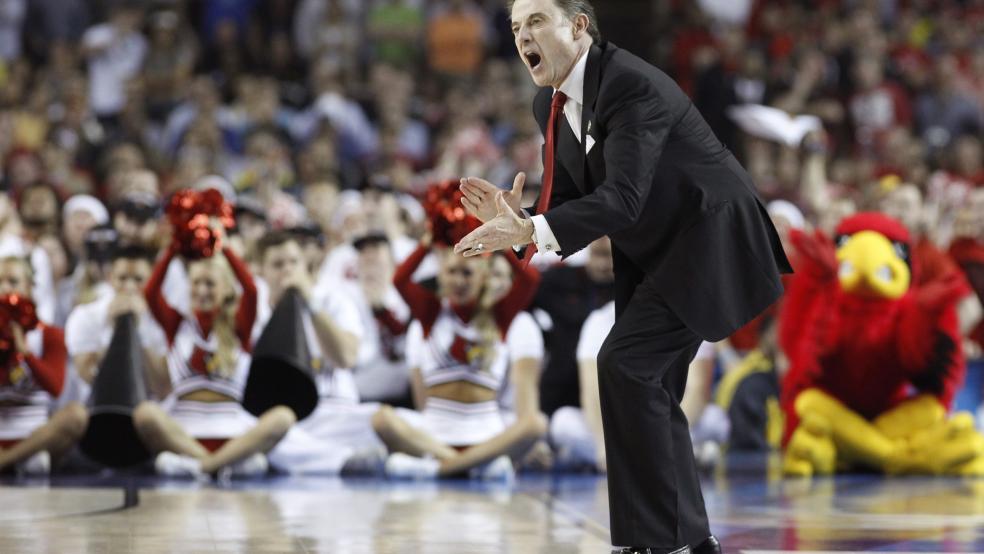Louisville University will be looking to defend more than one title as this year’s chase for the men’s college basketball championship heats up.
The school had the most profitable college hoops program in the country by far, earning $26.7 million from July 1, 2012, to June 30, 2013, according to figures from Vanderbilt University economist John Vrooman.
The Cardinals took in $42 million in revenue and had $15.6 million in expenses. Louisville’s long-time rival, the University of Kentucky, came in sixth place, earning $23 million in revenue and $9.5 million in profit, according to data from Vrooman.
The rest of the top 10 includes a who’s who of college basketball powerhouses: Syracuse University, Duke University, University of Arizona, Indiana University, University of Wisconsin and Ohio State University.
Related: The Real Sweet 16: College Basketball’s Most Profitable Programs
Consistent on-court success under coach Rick Pitino has certainly helped Louisville, but other factors have played a big part, too. “They are right in the heart of basketball country,” says Victor Matheson, professor of economics and accounting at College of the Holy Cross. “It also helps to be in a pretty big town without any other major sports” to compete for fans’ attention.
On average, about 21,282 fans attended Louisville home games in a publicly funded arena that accommodates 22,000. Profits from basketball are used to fund the university’s 22 other sports programs, according to a Louisville statement. Students didn’t “completely utilize the 2,300 sets set aside for them,” it said.
Louisville and its money-making Division I brethren however, are the exception rather than the rule. Vrooman estimates that there are about 50 profitable college basketball programs in the whole country. Many successful teams, such as Wichita State, either lose money or break even. A handful of colleges earn a profit on both basketball and football outside a major conference.
College basketball is expensive for many reasons. First, as Matheson notes, there is intense competition for coaches, even at smaller schools. They are often one of the five highest paid employees at a college. Unlike other sports teams, basketball teams are “fully scholarshipped,” he said.
Basketball stadiums are also much smaller than football stadiums, where colleges can earn big bucks selling luxury box seats. Smaller schools also get little television exposure, and little media revenue as a result.
“There are really not that many opportunities to make money,” Matheson said, referring to the smaller schools.
Related: The Man Who Might Take Down the NCAA
Manhattan College, which lost to Louisville Thursday, broke even on its basketball program. The small (3,675) student Roman Catholic school in New York City was making its first appearance in the tournament since 2004. Louisville, by contrast, has 40 tournament appearances, 10 Final Four appearances and three championships.
March Madness Money
Wichita State, which was undefeated this year and lost to Louisville in the Final Four last year, broke even on its program. It generated more than $5 million in revenue. Yet the publicity it generated with its tournament run may have been immensely more valuable.
Wichita State’s Partnership for the Advancement of Sports Management estimated that all of exposure the school got from the both traditional and digital media for its Final Four appearance was worth $555 million to the school, whose entire annual budget is only $291 million.
“A similar run in 2014 would likely garner even more exposure, thanks to continuous increases in advertising value during television broadcasts and the evolving digital world,” the university said in a press release. “Further studies on merchandise, admissions and other value to the university will continue to be forthcoming.”
Officials at Wichita State said its figures match up with what other schools that have reached the Final Four have found. The impact that the Final Four appearance is having on other areas such as admissions and merchandise sales is being studied. “What was surprising was the amount of exposure that was there,” said Mike Ross, one of the study’s authors.
Holy Cross’s Matheson disputes the idea that Final Four media exposure is valuable as the Wichita State researchers claim. The value of media mentions for a school declines the more that it occurs, he said. “You would never see any college spending this sort of money advertising itself,” he said.
Teams in the tournament earn about $250,000 per game for their conferences, which is paid out over a six-year period. Conferences are urged by the NCAA, but are not required, to distribute their money equally among their members.
Colleges, particularly those that fare unexpectedly well in the tournament, often note that an appearance in the March Madness tournament leads to an increase in applications and helps encourage more donations. Economists, though, reject this notion and argue that there isn’t any evidence that potential students inspired by the Final Four wind up enrolling.
Of course, there is plenty of money to be made from March Madness. CBS and Time Warner’s Turner Networks signed a 14-year, $11 billion broadcast rights deal with the NCAA in 2010. The companies reportedly earned $1 billion in advertising revenue in 2012 and should do well this year as well since 95 percent of their advertising inventory has been sold.
Top Reads from The Fiscal Times




